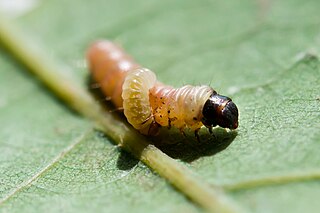Dichozoma is a monotypic moth genus of the family Crambidae erected by Eugene G. Munroe in 1961. Its only species, Dichozoma parvipicta, was first described by William Barnes and James Halliday McDunnough in 1918. It is found in North America, where it has been recorded from Arizona, California, Utah and Texas.
Mojavia is a monotypic moth genus of the family Crambidae erected by Eugene G. Munroe in 1961. It contains only one species, Mojavia achemonalis, which was first described by William Barnes and James Halliday McDunnough in 1914. It is found in North America, where it has been recorded from Arizona, California, Nevada, New Mexico and Texas.

Psilocorsis cryptolechiella is a moth of the family Depressariidae. It is found in the United States, including Alabama, Illinois, Massachusetts, Pennsylvania and South Carolina.

Psilocorsis reflexella is a species of moth of the family Depressariidae. It is found in North America, including Georgia, Illinois, New Jersey, New York, Oklahoma and Tennessee.

Psilocorsis quercicella is a species of moth of the family Depressariidae. It is found in the United States, including Florida, Maryland, Massachusetts and Oklahoma.
Walshia dispar is a moth in the family Cosmopterigidae. It was described by Ronald W. Hodges in 1961. It is found in North America, where it has been recorded from Ontario to Virginia.
Walshia exemplata is a moth in the family Cosmopterigidae. It was described by Ronald W. Hodges in 1961. It is found in North America, where it has been recorded from Maryland, Arkansas, Indiana, Ohio, West Virginia, South Carolina, Mississippi, Louisiana and Florida.
Walshia similis is a moth in the family Cosmopterigidae. It was described by Ronald W. Hodges in 1961. It is found in North America, where it has been recorded from Massachusetts, Michigan and from Illinois to South Carolina and Florida.

Psilocorsis is a genus of moths of the family Depressariidae.
Psilocorsis exagitata is a moth in the family Depressariidae. It was described by Edward Meyrick in 1926. It is found in Colombia.
Psilocorsis amydra is a moth in the family Depressariidae. It was described by Ronald W. Hodges in 1961. It is found in North America, where it has been recorded from Arizona.
Psilocorsis arguta is a moth in the family Depressariidae. It was described by Ronald W. Hodges in 1961. It is found in North America, where it has been recorded from Arizona.
Psilocorsis fatula is a moth in the family Depressariidae. It was described by Ronald W. Hodges in 1975. It is found in North America, where it has been recorded from Texas.
Dichomeris nenia is a moth in the family Gelechiidae. It was described by Ronald W. Hodges in 1986. It is found in North America, where it has been recorded from Texas, Arkansas, Alabama, Mississippi and Florida.
Dichomeris aglaia is a moth in the family Gelechiidae. It was described by Ronald W. Hodges in 1986. It is found in North America, where it has been recorded from Florida to Texas and in Louisiana, Mississippi, Alabama, North Carolina, South Carolina, Tennessee and West Virginia.

Dichomeris aleatrix, the buffy dichomeris moth, is a moth in the family Gelechiidae. It was described by Ronald W. Hodges in 1986. It is found in North America, where it has been recorded from southern Ontario south to Tennessee and north to Illinois.
Dichomeris pelta is a moth in the family Gelechiidae. It was described by Ronald W. Hodges in 1986. It is found in North America, where it has been recorded from South Carolina and Florida.
Dichomeris bolize, or Glaser's dichomeris moth, is a moth in the family Gelechiidae. It was described by Ronald W. Hodges in 1986. It is found in the United States, where it has been recorded from Nebraska, Connecticut, Florida, Maryland, Massachusetts, New Jersey, New York, North Carolina and Texas.
Dichomeris baxa is a moth in the family Gelechiidae. It was described by Ronald W. Hodges in 1986. It is found in North America, where it has been recorded from California.
Dichomeris euprepes is a moth in the family Gelechiidae. It was described by Ronald W. Hodges in 1986. It is found in North America, where it has been recorded from Kentucky and Florida.



